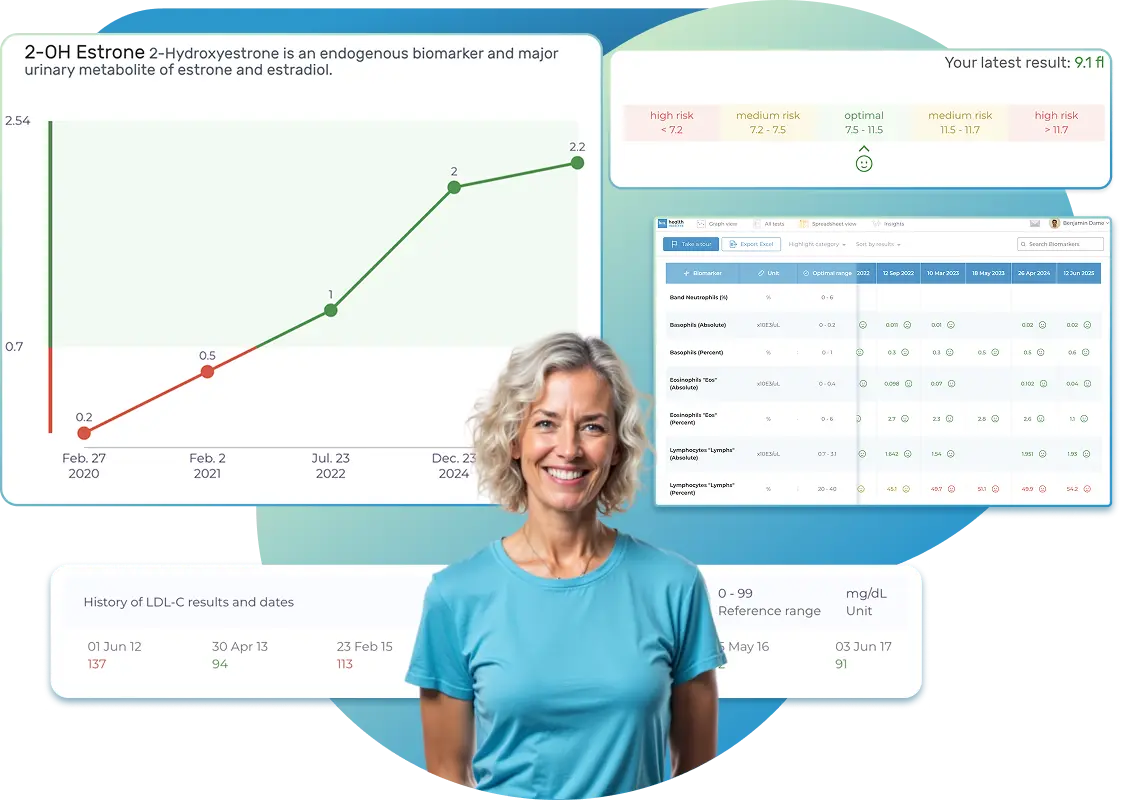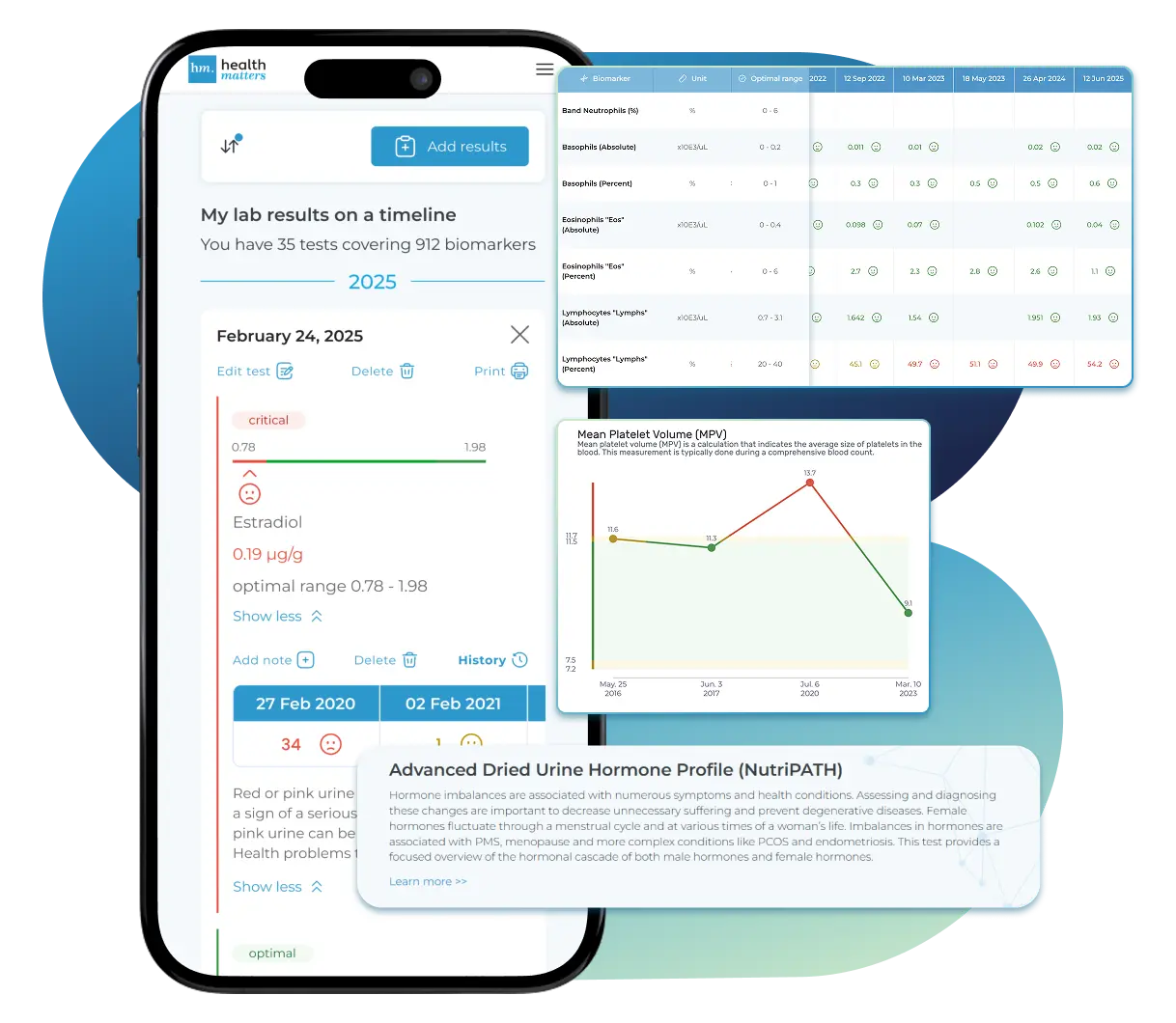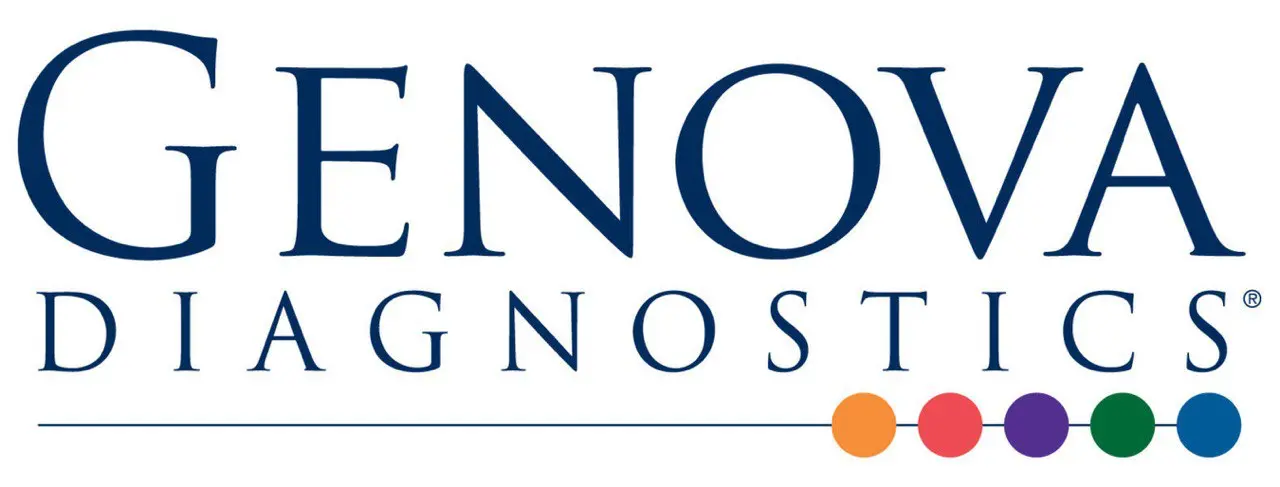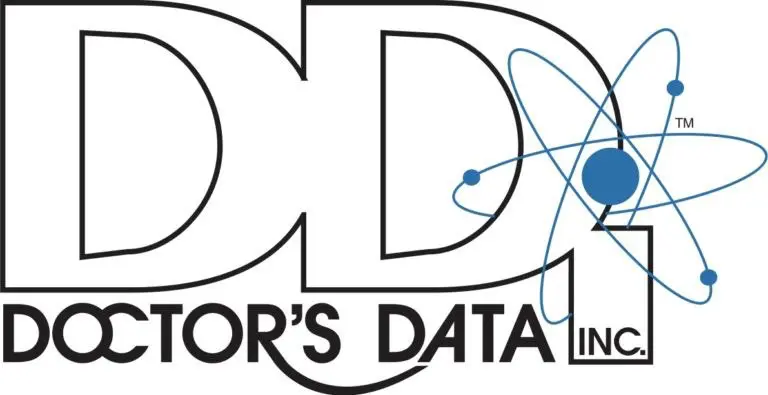Phenylalanine is an essential aromatic amino acid that serves as the biochemical starting point for several critical compounds in the body, including the catecholamine neurotransmitters — dopamine, noradrenaline, and adrenaline. On the Neurotransmitter XL panel, phenylalanine provides valuable insight into neurotransmitter synthesis capacity, stress metabolism, and amino acid balance.
Because the body cannot produce phenylalanine, it must be obtained from dietary protein sources such as meat, eggs, fish, dairy, soy, and legumes. Once absorbed, phenylalanine is converted into tyrosine via the enzyme phenylalanine hydroxylase (PAH), a process dependent on the essential cofactor tetrahydrobiopterin (BH4), as well as iron and vitamin B6. Tyrosine then serves as the substrate for dopamine synthesis, which can subsequently be converted into noradrenaline and adrenaline.
Thus, phenylalanine is the first building block in the catecholamine biosynthetic chain, influencing motivation, alertness, focus, stress resilience, and energy.
Phenylalanine plays a central role in:
Catecholamine production: the precursor of tyrosine, leading to dopamine, noradrenaline, and adrenaline.
Thyroid hormone synthesis: indirectly contributes to thyroxine (T4) formation.
Protein and peptide synthesis: required for the creation of structural and signaling proteins.
Pain modulation: through its conversion into endorphin-modulating compounds like phenylethylamine (PEA).
A sufficient supply of phenylalanine ensures optimal neurotransmitter and hormonal synthesis, while imbalances may impair mood regulation, energy levels, and cognitive performance.
Phenylalanine levels provide clues about both amino acid metabolism and neurotransmitter precursor flow. Because it sits at the top of the catecholamine pathway, deviations in phenylalanine can ripple downstream, affecting dopamine and adrenaline levels.
Low phenylalanine may indicate nutrient deficiency, stress-related overconsumption, or metabolic depletion of catecholamines.
High phenylalanine can occur with enzyme dysfunction, oxidative stress, or low BH4 activity, leading to impaired conversion to tyrosine.
Interpreting phenylalanine alongside tyrosine, dopamine, SAM/SAH ratio, and BH4-dependent pathways helps pinpoint whether the imbalance reflects substrate insufficiency or conversion blockage.
Phenylalanine → Tyrosine (via phenylalanine hydroxylase, with BH4, iron, and vitamin B6 as cofactors)
Tyrosine → L-DOPA → Dopamine → Noradrenaline → Adrenaline
Dopamine breakdown occurs via monoamine oxidase (MAO) and catechol-O-methyltransferase (COMT), both dependent on nutrients such as vitamin B2, SAM (S-adenosylmethionine), and magnesium.
When phenylalanine or its cofactors are lacking, this cascade slows down, affecting not only neurotransmitter balance but also energy and stress response.
Persistent psychological or physiological stress increases the turnover of dopamine, noradrenaline, and adrenaline. Over time, this heightened demand can deplete upstream precursors like phenylalanine and tyrosine, leading to reduced neurotransmitter synthesis and symptoms of burnout, low energy, and apathy.
Because phenylalanine must be obtained from dietary protein, inadequate intake or malabsorption (due to gut inflammation, enzyme insufficiency, or restrictive diets) can lead to deficiency.
Cofactor deficiencies — especially iron, vitamin B6, and BH4 — can also impair the conversion of phenylalanine to tyrosine, causing secondary imbalances even when phenylalanine intake is adequate.
The enzyme phenylalanine hydroxylase (PAH) converts phenylalanine to tyrosine. Low enzyme activity or reduced BH4 availability can lead to the accumulation of phenylalanine and insufficient downstream neurotransmitter synthesis. While genetic PAH defects cause phenylketonuria (PKU), mild functional inhibition can occur due to oxidative stress, toxin exposure, or chronic inflammation.
The cofactor BH4 (tetrahydrobiopterin) is regenerated via methylation-dependent reactions. Low methylation capacity (reflected in a low SAM/SAH ratio) or oxidative depletion of BH4 can reduce PAH enzyme activity. This can result in both elevated phenylalanine and low dopamine synthesis despite adequate precursor levels.
Inflammation-induced oxidative stress degrades BH4 and disrupts phenylalanine metabolism. Elevated neopterin levels on the Neurotransmitter XL panel often indicate immune activation, suggesting a shift in tryptophan and phenylalanine metabolism toward stress defense rather than neurotransmitter synthesis.
Fatigue, low motivation, and “flat” affect
Brain fog and difficulty focusing
Depressed mood or apathy
Low blood pressure or stress intolerance
Decreased dopamine and adrenaline output
Muscle weakness or slow recovery from exertion
Low mood or anxiety (due to reduced dopamine production)
Irritability and cognitive sluggishness
Possible “bottleneck” in catecholamine synthesis
Signs of oxidative stress or BH4 depletion
| Related Marker | Interpretation Insight |
|---|---|
| Tyrosine | Low phenylalanine with low tyrosine indicates precursor depletion; high phenylalanine with low tyrosine suggests poor conversion (PAH or BH4 issue). |
| Dopamine / Noradrenaline / Adrenaline | Low downstream catecholamines confirm impaired conversion efficiency or overuse under stress. |
| BH4 (Tetrahydrobiopterin) | Low levels impair phenylalanine hydroxylation and serotonin synthesis. |
| SAM / SAH Ratio | Low ratio reflects methylation slowdown, reducing BH4 regeneration and enzyme function. |
| Neopterin | Elevated levels indicate inflammation consuming BH4 and suppressing phenylalanine metabolism. |
Together, these insights help distinguish between nutrient deficiency, enzyme inhibition, and inflammatory stress as causes of phenylalanine imbalance.
Persistent abnormalities in phenylalanine metabolism can contribute to:
Low catecholamine tone — reduced alertness, motivation, and stress response.
Mood disorders — especially depression, apathy, or attention deficits.
Cognitive fatigue — due to impaired dopamine transmission.
Autonomic imbalance — poor regulation of blood pressure and energy.
Amino acid and redox stress — depletion of cofactors like BH4 and SAM.
Over time, insufficient phenylalanine metabolism can feed into neurotransmitter exhaustion, mitochondrial inefficiency, and emotional burnout.
Ensure sufficient protein and amino acid intake from diverse sources.
Replete key cofactors: vitamin B6, iron, folate, magnesium, zinc, and vitamin C.
Support BH4 regeneration with folate, SAM, and antioxidants (vitamin C, NAC, lipoic acid).
Maintain adequate methyl donors (choline, betaine, SAMe) for BH4 recycling.
Reduce oxidative stress with antioxidants and omega-3 fatty acids.
Manage chronic stress through relaxation training, mindfulness, and restorative sleep.
Avoid overstimulation from excess caffeine or nicotine, which increase catecholamine demand.
Elevated neopterin or low BH4 may call for anti-inflammatory support (e.g., curcumin, resveratrol, DHA).
Investigate possible gut inflammation or toxin exposure interfering with amino acid metabolism.
Phenylalanine is the foundation of the dopamine and adrenaline synthesis pathway—a key determinant of mood, focus, and energy. On the Neurotransmitter XL panel, it reflects both nutritional status and enzyme function within the catecholamine system.
Low levels typically signify nutrient deficiency or overconsumption under chronic stress, while high levels often point to conversion blockages linked to BH4 or methylation deficits.
Interpreting phenylalanine alongside tyrosine, dopamine, SAM/SAH, and neopterin helps identify whether the imbalance stems from amino acid insufficiency, enzyme inhibition, or inflammatory stress.

Import lab results from multiple providers, track changes over time, customize your reference ranges, and get clear explanations for each result. Everything is stored securely, exportable in one organized file, and shareable with your doctor—or anyone you choose.
Cancel or upgrade anytime

A low phenylalanine level on the Neurotransmitter XL panel typically points to insufficient dietary intake, malabsorption, or increased metabolic demand for catecholamine synthesis. Because phenylalanine is an essential amino acid — one that the body cannot make — it must be obtained through diet and properly absorbed and converted to sustain optimal brain and nervous system function.
Low phenylalanine can reduce the body’s ability to produce tyrosine, dopamine, noradrenaline, and adrenaline, affecting energy, motivation, focus, and mood regulation. It may also signal nutrient or cofactor deficiencies (such as iron, vitamin B6, or BH4), chronic stress, or overactivation of catecholamine pathways, all of which increase demand for this critical amino acid.
In essence, low phenylalanine represents a substrate limitation at the very start of the catecholamine pathway — where the body no longer has enough raw material to keep up with neurotransmitter and stress hormone synthesis.
Phenylalanine is converted to tyrosine via the enzyme phenylalanine hydroxylase (PAH), which requires:
Tetrahydrobiopterin (BH4) as a cofactor
Iron and vitamin B6 for enzyme activity
Folate and SAM (S-adenosylmethionine) to regenerate BH4
Tyrosine then leads to dopamine, noradrenaline, and adrenaline production — neurotransmitters that regulate attention, motivation, and the body’s stress response.
When phenylalanine is low, the entire catecholamine cascade can become sluggish, leading to reduced neurotransmitter signaling and symptoms such as low energy, emotional flatness, or poor stress resilience.
Phenylalanine is found in protein-rich foods like eggs, poultry, beef, fish, soy, legumes, and dairy. Low dietary intake, restrictive eating patterns (e.g., vegan or very low-protein diets), or excessive fasting can lead to phenylalanine deficiency.
Because the body cannot store amino acids in large quantities, sustained low intake quickly affects circulating levels.
Conditions that reduce intestinal absorption — such as celiac disease, inflammatory bowel disease, SIBO, or pancreatic insufficiency — can lead to low amino acid levels even when dietary intake is adequate.
A disrupted gut microbiome may also impair digestion and absorption of amino acids.
Chronic psychological or physiological stress increases dopamine and noradrenaline turnover, which consumes large amounts of phenylalanine and tyrosine.
When stress persists without adequate recovery, amino acid precursors become depleted, leading to reduced neurotransmitter synthesis and “burnout” symptoms such as fatigue, apathy, and low motivation.
Conversion of phenylalanine to tyrosine relies on:
Iron (for PAH enzyme function)
Vitamin B6 (for neurotransmitter synthesis steps)
BH4 (tetrahydrobiopterin) — a critical cofactor regenerated through methylation and antioxidant processes
Deficiencies in these nutrients or impaired methylation (e.g., low SAM/SAH ratio) can slow or block conversion, causing functional low phenylalanine activity even if measured levels are near-normal.
Low BH4 due to oxidative stress, inflammation, or poor methylation prevents efficient conversion of phenylalanine into tyrosine.
Markers such as low SAM/SAH ratio or elevated neopterin on the Neurotransmitter XL panel often signal this problem.
Physical overexertion and immune activation (e.g., viral or inflammatory illness) can increase demand for amino acids, diverting phenylalanine into repair and immune processes instead of neurotransmitter synthesis.
This can manifest as post-exertional fatigue, low motivation, and mood flattening.
Low phenylalanine may manifest subtly at first but can lead to broader neurochemical and metabolic effects over time. Common signs include:
Fatigue or reduced physical stamina
Low motivation and apathy (“flat” mood)
Brain fog, poor concentration, or forgetfulness
Low blood pressure or stress intolerance
Depressive or anxious tendencies (due to low dopamine and noradrenaline)
Cold extremities or sluggish metabolism
Poor exercise recovery and slow wound healing
Because dopamine and adrenaline stem from phenylalanine, symptoms often resemble catecholamine depletion — the body’s “energy and drive” molecules running low.
| Related Marker | Interpretation Insight |
|---|---|
| Tyrosine | Low phenylalanine with low tyrosine suggests precursor deficiency; low phenylalanine with normal tyrosine may reflect reduced dietary intake but intact conversion. |
| Dopamine / Noradrenaline / Adrenaline | Low downstream neurotransmitters confirm reduced phenylalanine availability or excessive catecholamine turnover. |
| BH4 (Tetrahydrobiopterin) | Low BH4 limits phenylalanine hydroxylation, compounding the deficiency’s effects. |
| SAM / SAH Ratio | A low ratio indicates poor methylation, reducing BH4 regeneration and impairing phenylalanine conversion. |
| Neopterin | Elevated levels suggest immune-driven BH4 depletion, leading to slower phenylalanine metabolism. |
Together, these markers clarify whether low phenylalanine is due to dietary deficiency, metabolic stress, or cofactor insufficiency.
Persistent low phenylalanine may contribute to:
Low catecholamine output, reducing alertness and drive
Depressive symptoms or low motivation from dopamine depletion
Cognitive slowing and poor memory
Physical and mental fatigue
Impaired stress tolerance
Slow recovery and loss of resilience
If unaddressed, this can progress into a pattern of chronic low energy and emotional blunting driven by neurotransmitter depletion.
Include phenylalanine-rich foods daily: turkey, chicken, eggs, fish, tofu, soybeans, lentils, pumpkin seeds, and dairy.
Consider a balanced amino acid supplement under professional supervision if dietary intake is low.
Ensure sufficient iron, vitamin B6, magnesium, folate, B12, and vitamin C.
Support BH4 regeneration through methylation cofactors like SAMe, choline, and betaine.
Antioxidants such as vitamin C, NAC, and alpha-lipoic acid protect BH4 from oxidative degradation.
Practice stress-reducing techniques (mindfulness, yoga, slow breathing).
Ensure adequate sleep and rest days between intense exercise.
Limit excess caffeine, nicotine, and stimulants that increase catecholamine turnover.
Address gut inflammation or dysbiosis that may limit amino acid absorption.
Consider digestive enzyme support if protein breakdown is suboptimal.
Low phenylalanine indicates that the body’s supply of a key catecholamine precursor is insufficient to sustain healthy neurotransmitter and stress response function. This often stems from low dietary protein intake, chronic stress, or cofactor deficiencies (especially BH4, B6, and iron).
Interpreting phenylalanine alongside tyrosine, dopamine, BH4, SAM/SAH ratio, and neopterin on the Neurotransmitter XL panel provides a detailed picture of where catecholamine synthesis may be faltering.
Laboratories
We accept reports from any lab, so you can easily collect and organize all your health information in one secure spot.











Pricing Table
Choose the plan that fits you — and turn scattered lab reports into clear insights you can finally use.
Pick a plan that fits you — and turn scattered lab reports into clarity.
Personal plans
Professional plan
$15/ month
Access your lab reports, explanations, and tracking tools.
$250/ once
Pay once, access everything—no monthly fees, no limits.
Professional plan
$45/ month
Designed for professionals managing their clients' lab reports
About membership
 Import Lab Results from Any Source
Import Lab Results from Any Source
Easily upload lab results from any provider, whether it's a hospital, independent lab, or home testing service. We support PDFs, scanned documents, and JPEGs from patient portals. No need to log in to multiple platforms — everything is centralized in one secure space.
Easily upload lab results from any provider — we support PDFs, scans, and images. Keep all your reports organized in one secure place.
 See Your Health Timeline
See Your Health Timeline
Every lab result is automatically organized on a chronological timeline, giving you a complete picture of your health journey. Whether you're tracking a condition, managing treatments, or staying proactive, the timeline helps you and your doctor understand how things progress over time.
Every lab result is automatically organized on a chronological timeline, giving you a complete picture of your health journey.
 Understand What Your Results Mean
Understand What Your Results Mean
Whether it's a blood test, GI panel, urinalysis, or something else, lab reports measure numerous biomarkers that reveal what's happening inside your body. Our extensive database covers over 10,000 biomarkers, providing clear, simple explanations of what each result means and how you can take action—no matter your membership level. Say goodbye to confusion and get the insights you need to better understand your health.
Our database covers over 10,000 biomarkers with clear, simple explanations—so you can finally understand your results and what to do next.
 Enter Your Lab Reports Yourself — Always Free
Enter Your Lab Reports — Always Free
Enter Your Lab Reports Yourself — Always Free
Enter Your Lab Reports — Always Free
If you'd like to handle inputting your health data into your account, you can do so with our easy-to-use data entry forms. Our user-friendly form is designed to guide you through the quick and easy submission process, making it simple to keep track of your health metrics. This is available to both Complete plan and Unlimited plan members.
Our user-friendly form guides you through a quick, simple submission process, making it easy to enter your health metrics.
Add your results anytime with our easy entry form. It's quick, guided, and helps you stay organized — free for all members.
 Visualize Your Results
Visualize Your Results
View your lab data through easy-to-read graphs and tables. Quickly spot patterns, track changes, and compare results across different dates — all without digging through multiple reports. You can also select and compare graphs of specific biomarkers side-by-side to better understand how they relate and change over time.
See your lab reports in clear graphs and tables. Spot patterns, track changes, and compare results over time — all in one place.
 Export Your Complete Lab History in a Single File
Export Your Complete Lab History
Export Your Complete Lab History in a Single File
Export Your Complete Lab History
After collecting lab results from different providers, you can download your entire history combined into a single file. Choose from PDF, Excel, or CSV formats to easily review, share, or get a second opinion—no more juggling multiple reports.
After collecting lab results from different providers, you can download your entire history combined into a single file.
 Comprehensive Data Entry Service for Your Reports
Data Entry Service for Your Reports
Comprehensive Data Entry Service for Your Reports
Data Entry Service for Your Reports
Our inclusive service handles the data entry for your lab reports. Just submit your information and we'll take care of the rest. Complete plan members receive one report entered for free, then $15 per report after that. Unlimited plan members receive ten report entries for free, then $15 per report after that.
Our inclusive service handles the data entry for your lab reports. Just submit your information and we'll take care of the rest.
 Securely Share With Anyone You Trust
Securely Share With Anyone You Trust
Whether you're working with a doctor, nutritionist, caregiver, or wellness coach, you can securely share your complete lab history by sending an invite link to anyone you trust. You have full control over who sees your information and for how long, ensuring your privacy and peace of mind at every step.
Share your full lab history with your doctor, nutritionist, or coach using a secure invite link.
Discover






I have been using Healthmatters.io since 2021. I travel all over the world and use different doctors and health facilities. This site has allowed me to consolidate all my various test results over 14 years in one place. And every doctor that I show this to has been impressed. Because with any health professional I talk to, I can pull up historical results in seconds. It is invaluable. Even going back to the same doctor, they usually do not have the historical results from their facility in a graph format. That has been very helpful.
Anthony
Unlimited Plan Member since 2021

What fantastic service and great, easy-to-follow layouts! I love your website; it makes it so helpful to see patterns in my health data. It's truly a pleasure to use. I only wish the NHS was as organized and quick as Healthmatters.io. You've set a new standard for health tracking!
Karin
Advanced Plan Member since 2020

As a PRO member and medical practitioner, Healthmatters.io has been an invaluable tool for tracking my clients' data. The layout is intuitive, making it easy to monitor trends and spot patterns over time. The ability to customize reports and charts helps me present information clearly to my clients, improving communication and outcomes. It's streamlined my workflow, saving me time and providing insights at a glance. Highly recommended for any practitioner looking for a comprehensive and user-friendly solution to track patient labs!
Paul
Healthmatters Pro Member since 2024
Healthmatters is a personal health dashboard that helps you organize and understand your lab results. It collects and displays your medical test data from any lab in one secure, easy-to-use platform.
With a Healthmatters account, you can:
Professionals can also analyze client data more efficiently and save time managing lab reports.
Healthmatters.io personal account provides in-depth research on 4000+ biomarkers, including information and suggestions for test panels such as, but not limited to:
You can combine all test reports inside your Healthmatters account and keep them in one place. It gives you an excellent overview of all your health data. Once you retest, you can add new results and compare them.
If you are still determining whether Healthmatters support your lab results, the rule is that if you can test it, you can upload it to Healthmatters.
While we work with many popular labs, we welcome reports from lots of other places too.
It's as simple as this: if you can get a test done, you can upload it to Healthmatters and we can interpret results from any lab out there. If laboratories can analyze it, we can interpret it.
If you're on the hunt for a specific biomarker, contact us and we'll add it to our database. Anything from blood, urine, saliva, or stool can be uploaded, understood, and tracked with your Healthmatters account.
The Complete Plan ($15/month) is perfect for individuals who want ongoing access to their health data. It includes unlimited lab imports, visual tracking, custom ranges, result explanations, full account exports, and secure sharing — all with a simple monthly subscription. You can cancel anytime and restart your plan whenever you're ready — your data will still be there waiting for you. You can also upgrade to the Unlimited Plan at any time, with the cost prorated based on what you've already paid.
The Unlimited Plan ($250 one-time) is also designed for individuals but offers lifetime access with no ongoing subscription. You'll get all the same features as the Complete Plan, plus a larger initial data entry allowance (10 reports), making it a great choice if you prefer a one-time payment and long-term use without monthly fees.
In short:
There are two ways to add your test reports to your Healthmatters account. One option is to input the data using the data entry forms. The other method is to utilize our "Data entry service."
Our data entry forms offer an easy, fast, and free way for you to input the reports yourself. Self-entry allows you to add an unlimited number of reports at no cost. We make the self-entry process user-friendly, providing dozens of templates that pre-populate the most popular laboratory panels and offering instant feedback on entered values.
For those who prefer assistance, we offer a "Data entry service" to help you input your data. Simply attach an image or file of your lab test results, and a qualified team member from our data entry team will add the results for you.
We support various file types, including PDFs, JPGs, or Excel. This service is particularly useful if you have many reports to upload or if you're too busy to handle the data entry yourself.
Our Data Entry Service is for when you don't want to manually type in your lab results yourself. You simply upload your report (PDF, image, or screenshot), and our trained team enters the information into your Healthmatters account for you — accurately and neatly organized, ready to view in graphs, tables, and timelines.
The $15 per report covers the time and care it takes for a real person to review your file, make sure each result is entered correctly, and double-check for accuracy. This ensures your health data is precise and easy to work with — without you having to spend the time doing it yourself.
Prefer to do it yourself? You can always use our free self-entry tool to add results manually — it just takes a bit more time and attention.
For users on the Complete monthly plan, the first report is entered free of charge, and each additional report incurs a fee of $15.
Unlimited account holders enjoy the entry of ten reports without charge. Subsequent reports are subject to a $15 fee per report.
Additionally, users on the Complete plan can upgrade to a yearly subscription from the account settings. The annual subscription includes a data entry service for five reports.
All professional accounts allow you to import and onboard an unlimited number of clients and their lab results. The distinction between professional plans lies solely in the data entry service.
The Pro Monthly Plus plan is priced at $75 per month and includes a data entry service for five reports each month. Additional reports can be self-entered at no extra cost or, if preferred, you can use our data entry service for an additional fee of $15 per report.
The Pro Monthly plan is priced at $45 per month and does not include a data entry service. Self-entry is free for an unlimited number of reports, and you can opt for the data entry service at a fee of $15 per report.
You also have the option to upgrade to higher monthly or to annual plans, which come with substantial discounts. All upgrades can be done directly from your account.
Simply log in and navigate to your account settings to cancel your subscription. Scroll down to locate the 'Cancel' button at the bottom of the page. Ensure you cancel at least one day before the renewal date to prevent any charges. Once cancellation is requested, the subscription remains active until the conclusion of the current billing cycle.
Our goal has been to make your Healthmatters account as intuitive as possible.
We've crafted multiple ways for you to navigate your data, whether you're glancing at a single report or delving into your historical test reports.
1. Graph View:Dive into a visual journey with our biomarker graphs, showcasing over 40 data points. Combining years of results unveils trends, empowering you to make informed decisions. Our visualization tools make it a breeze to compare and understand changes over time, even if your results are from different labs. A search function and filters simplify the exploration of extensive data, allowing you to focus on what needs attention.
2. All Tests ViewExplore neatly organized reports on a timeline, highlighting crucial details like dates, critical results, and lab/panel names. Each report opens up to reveal in-depth descriptions and additional recommendations for each biomarker. The history of previous results is just a click away, and you can download a comprehensive report for deeper insights. Color-coded and user-friendly, it's designed for easy reading, understanding, and navigation.
3. Table View:For a holistic view of all biomarkers side by side, our table view is your go-to. Results are neatly displayed in a categorized and dated table, ideal for those with an extensive test history. Utilize sorting, filters, and color-coding to enhance your analysis and gain extra insights.
Yes, you can download your information anytime. We offer two easy ways to export your lab data:
This makes it simple to save, back up, or share your health data whenever you need.
Yes, you can print your report. To do so, navigate to "All tests" and open the report you wish to print. You'll find a print button in the right corner of the report. Click on it, and your browser's print window will open. If you prefer to print in a bigger typeface, adjust the scale using the print window settings.
Yes, you can! We highly recommend activating Two-Factor Authentication (2FA) for your account. To do so, please navigate to the "Profile and Security" section of your account, where you will find instructions for activating 2FA.
Yes, you can. When entering values for the biomarker, you will see an "Edit Range" button. Click this button, and you'll have the option to enter a custom range.
A personal account is all about keeping your own lab test results in check. It's just for you and your personal use.
The professional account is designed for health professionals who wish to track and organize their clients' laboratory results.
To learn more about Healthmatters Pro, please refer to the professional page.
At HealthMatters, we're committed to maintaining the security and confidentiality of your personal information. We've put industry-leading security standards in place to help protect against the loss, misuse, or alteration of the information under our control. We use procedural, physical, and electronic security methods designed to prevent unauthorized people from getting access to this information. Our internal code of conduct adds additional privacy protection. All data is backed up multiple times a day and encrypted using SSL certificates. See our Privacy Policy for more details.

